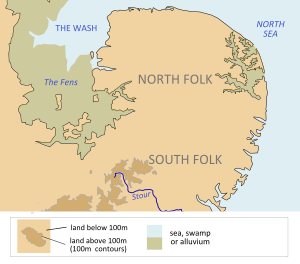Wehha of East Anglia facts for kids
Quick facts for kids Wehha |
|
|---|---|
'Wehh Wilhelming' from the Textus Roffensis
|
|
| King of the East Angles | |
| Reign | unknown |
| Successor | Wuffa of East Anglia |
| Died | c. 571 |
| Dynasty | Wuffingas |
| Religion | Anglo-Saxon Paganism |
Wehha of East Anglia was an early king of the East Angles, according to old Anglo-Saxon records. He might have been a pagan king in the 500s. During his time, new people from places like Frisia (now part of the Netherlands and Germany) and southern Jutland (now Denmark) were settling in the area. They were forming a new kingdom called East Anglia.
Wehha belonged to the Wuffingas family, a powerful group that started in the east of Suffolk. We don't know much about his time as king. Old records, like the Textus Roffensis, say Wehha was the son of Wilhelm. Another old book, the History of the Britons, calls him 'Guillem Guercha'. It says he was the first king of the East Angles. His son, Wuffa, was also a king. The Wuffingas family was named after Wuffa.
Some people think the name Wehha is a short version of Wihstān. This name appears in the old Anglo-Saxon poem Beowulf. This idea, along with things found at Sutton Hoo, suggests a link. It might mean the Wuffingas family was connected to a Swedish royal family called the Scylfings.
Contents
The Kingdom of East Anglia

Wehha is believed to be the first ruler of East Anglia. This was an independent Anglo-Saxon kingdom. It was formed in the 500s. Today, this area includes the English counties of Norfolk and Suffolk.
Historians think that people from southern Jutland quickly took over an area in southeast Suffolk. By about 550, they had conquered all of East Anglia. Wehha, as the founder of the Wuffingas family, was likely one of the leaders of these new people. Some historians have even linked the East Angles to the Geats from the poem Beowulf.
Old finds from Sutton Hoo also suggest a link to Sweden. A sword, helmet, and shield found in a ship burial at Sutton Hoo might have been family treasures. They could have been brought from Sweden in the early 500s. However, it is now thought these items were made in England. So, the direct link between the Wuffingas and Sweden is less certain.
The kingdom of the East Angles was surrounded by natural borders. The North Sea was to the north and east. Thick forests were to the south. To the west were the Fens, an area of swamps and islands. The main land route into East Anglia was a path called the Icknield Way. The East Angles' southern neighbours were the East Saxons. Across the Fens were the Middle Angles. Some believe the Devil's Dyke (near Newmarket) was part of the kingdom's western border. But this earthwork was built between the 4th and 10th centuries. So, it might not be from the very early Anglo-Saxon period.
Wehha's Family Tree
Wehha is a figure from history who may or may not have truly existed. There is no clear proof that he was a real king of the East Angles. His name, Wehha, is found in lists of the ruling Wuffingas family. For example, in the Textus Roffensis, he is called Ƿehh Ƿilhelming. This means "Wehha, son of Wilhelm." The Textus Roffensis is an important collection of old laws and church records.
Another old list, called the Anglian collection, also mentions Wehha. According to this list, Wehha was the son of Wilhelm. Wilhelm was the son of Hryþ, and so on, all the way back to the god Wōden. Wehha's son, Wuffa, is also listed. The Wuffingas family was named after Wuffa.
The 9th-century book History of the Britons says that 'Guillem Guercha' was the first of his family to rule the East Angles. This book also lists his family members. It says: "Woden begat Casser, who begat Titinon, who begat Trigil, who begat Rodmunt, who begat Rippa, who begat Guillem Guercha, who was the first king of the East Angles." Some historians think 'Guercha' is another way of saying 'Wuffa'. This suggests that Wuffa's father was the one who started the Wuffingas family line.
Even though the Wuffingas family had a long list of ancestors, their power in the region likely began in the mid-500s. This is if Wehha is considered the first king of their family. Historians warn that we should be careful when using the few records we have. It is hard to know many details about the earliest Wuffingas kings.
The descendants of Wehha
| Wehha | |||||||||||||||||
| Wuffa | |||||||||||||||||
| Tytila | |||||||||||||||||
| Rædwald | Eni | ||||||||||||||||
- See Wuffingas for a more complete family tree.
What Does the Name Wehha Mean?
The name Wehha might be a short version of Wihstān. Wihstān was the father of Wiglaf in the poem Beowulf. This idea supports the link between the Wuffingas family and the Swedish royal family, the Scylfings. It has also been suggested that Wehha is a common short form of Old English names that start with Wē(o)h-. An example could be a name like *Weohha, though we don't have records of it.
The name Wehha might also appear on a bronze bucket. This bucket was found at the Chessell Down cemetery on the Isle of Wight. It has a runic inscription that reads wecca.
Wehha's Time as King
We don't know anything about Wehha's rule. No written records from this time in East Anglian history have survived. At some point, Wehha was followed by his son, Wuffa. A medieval writer named Roger of Wendover said Wuffa was ruling the kingdom in 571. However, this date cannot be proven by other sources.

